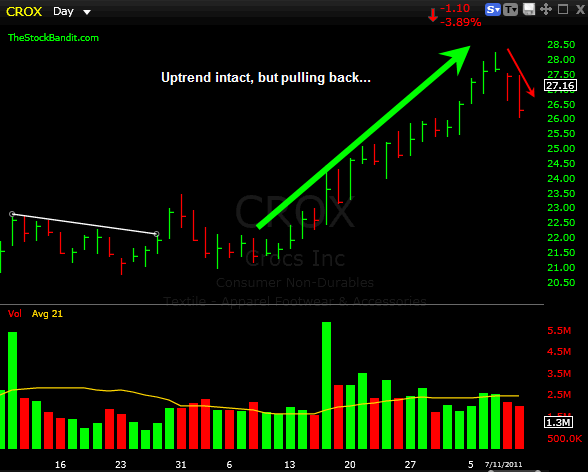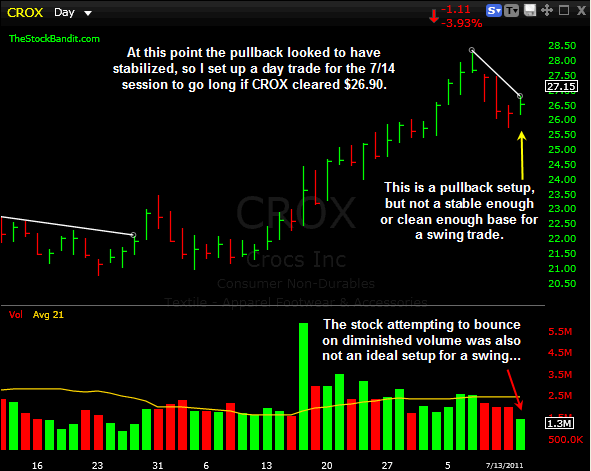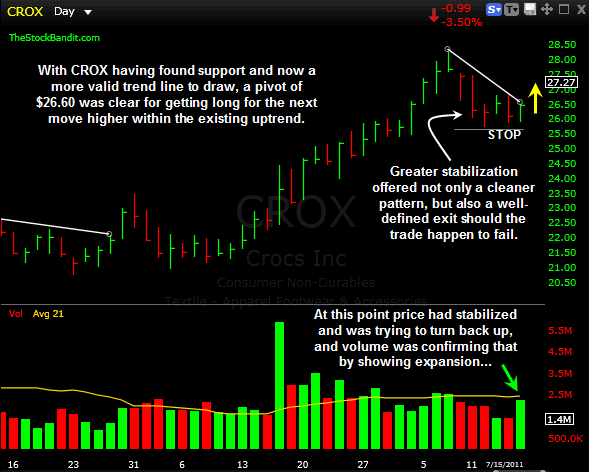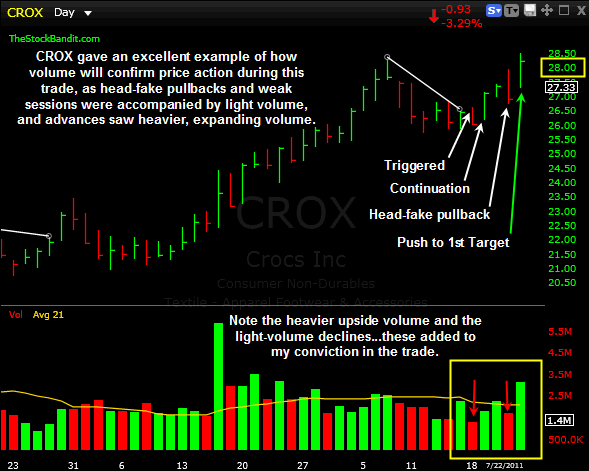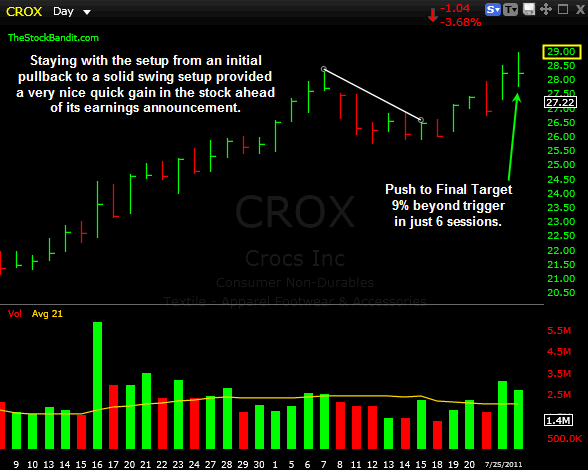One of the things I’m asked about quite often is how I decide my timeframe for a good setup. Will it be a day trade or a swing trade?
That’s a great question, and it took me a long time to figure that out. I go in-depth in the Advanced Trading Course [1] at TheStockBanditUniversity.com to explain it fully, but one component in the decision is the pattern quality. That’s going to encompass the risk associated with the trade, which means entries and exits are more defined by a cleaner, mature pattern [2] vs. one which is simply building.
So rather than just talk about it, I wanted to show you an excellent example from last week of how a stock can go from being simply a day trade candidate to a swing trade candidate when the pattern matures.
I had run across CROX pulling back from its 7/7 high on 7/11. The uptrend was still very much intact, and this looked to be a potential dip to buy once the dip was completed. Here it was at that time:
Chart courtesy of TeleChart [4]
CROX needed to be watched a little longer before a play was evident, as I wanted to be able to draw a clean trend line along the highs and then go long on a push through that trend line. Sometimes you have to wait on the market [5]. It took a couple of days, but I finally listed it for subscribers on the night of 7/13 for a day trade the following day. It wasn’t a fully mature pattern, so I was only interested in grabbing the next pop if it occurred the next day (7/14). Here was the setup, which didn’t trigger (it stopped a few cents shy of clearing the trend line, therefore no trigger):
Chart courtesy of TeleChart [4]
Despite not triggering an entry for a day trade, I kept CROX on the radar nonetheless. After two more daily bars had been painted on the chart, a cleaner trend line could be drawn, and the pullback had the appearance of greater stabilization. I then set up a swing trade since the pattern was more mature, the pivot was more evident, and a stop loss area was now well-defined. Here was the setup I posted for subscribers along with a $26.60 entry trigger price, a $25.70 stop loss (just beneath newfound support), and upside targets at $28 and $29:
Chart courtesy of TeleChart [4]
From there, CROX triggered an entry on 7/18, dipped for a day on weak volume, then got back on the move. With Target 1 at $28, the stock stopped just a few cents shy of hitting that level on 7/21, creating a bearish engulfing bar. However, I stayed with the trade since volume didn’t confirm distribution, and the following day the stock blew through the $28 first target on much heavier volume.
Chart courtesy of TeleChart [4]
CROX pushed all the way to Target 2, topping out exactly at $29 on Monday. That offered a nice quick 9% gain, allowing me to book a solid profit ahead of the August 1st earnings announcement (which I always avoid). Here’s a look at the final bar of my trade:
Chart courtesy of TeleChart [4]
Several takeaways…
Allow setups to determine your trade timeframe. I’ve said it many times, but the smaller the pattern, the shorter the trade should last. Bigger patterns can be trusted for more, it’s just that simple. This started out as a day trade candidate but evolved into a swing trade setup after the pattern grew and matured.
Be patient as patterns build. I stalked this stock for several days before placing a trade. Waiting for stocks to “come to you” is the best way to improve your odds of success. Risk management is crucial, pattern awareness is important, and position sizing is not something to ignore. However, it all begins with making a limited-risk entry, so timing is everything. Don’t rush the process.
Monitor the volume in relation to the price action. This stock made a few moves which, based on price alone, would have made me wonder. The trigger day saw a weak finish. Four days into the trade a bearish engulfing bar could have spooked me out. But neither were confirmed by volume. Instead, I kept seeing volume expansion along with advances in price, which gave me conviction in the trade and allowed me to stick with it.
Stick with good trades and don’t get shaken out. Along with the previous point on conviction, staying with a good trade can be tough. The price action or the overall market activity can cause premature evacuation. Stick with your trade plan and what the overall trade is doing. If it pulls back but volume’s weak, stay with your existing stop. It could just be a head fake on the way to much higher prices.
Hopefully this walk-through helps you understand better how I determine my timeframe for a trade. Beyond that, this review should also give you some insights into managing trades along the way, because learning to assess how a trade is developing is a critical skill you must possess for trading success.
If you want to know what I’m trading tomorrow, stop by the site and begin your trial to our stock pick service [6].
Trade Like a Bandit!
Jeff White
Producer of The Bandit Broadcast [7]
Follow TheStockBandit on Twitter [8] or Facebook [9] to keep up!
